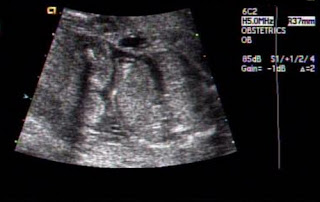What is a potter's syndrome?
It is named after Edith Potter, a pathologist who first described the characteristics of a Potter's syndrome. A Potter's syndrome is the term used to describe an infant with unusual physical appearance secondary to pressure in the uterus caused by oligohydramnios. The infant has a recessed chin, low set, cartilage deficient ears, parrot-beaked nose, and a prominent epicanthal fold. (1, 2)Potter's Syndrome Pictures
picture 1: A typical manifestation of a child with Potter's syndrome.
image source: syndromepictures.com
picture 2: A closer look at a child with Potter's syndrome.
image source: bp.blogspot.com
picture 3: A child who was diagnosed with Potter's syndrome at birth.
image source: childrenshospitals.typepad.com
picture 4: An imaging study of a woman whose baby inside the womb has potter's syndrome.
image source: medscapestatic.com
picture 5: Management of an infant with potter's syndrome.
image source: rackcdn.com
picture 6: An infant diagnosed with Potter's syndrome.
image source: rackcdn.com
Types of potter's syndrome
- Type I - The kidneys are enlarged and have small fluid-filled cysts.
- Type II - Absence of one kidney or complete agenesis.
- Type III - Autosomal dominant polycystic kidney disease.
- Type IV- A long-standing obstruction in the ureter or kidney. (2, 3, and 4)
What causes potter's syndrome?
The primary cause of potter's syndrome is kidney failure. It is the kidneys that produce amniotic fluid in the form of urine. It could also be due to the rupture of the amniotic sac during pregnancy. The amniotic sac contains the amniotic fluid, which is important in the development of the fetus.
It protects the fetus inside the womb. Possible reasons behind the rupture of the amniotic sac are maternal trauma, maternal genetics, and environmental factors. (4, 5, and 6)
It protects the fetus inside the womb. Possible reasons behind the rupture of the amniotic sac are maternal trauma, maternal genetics, and environmental factors. (4, 5, and 6)
Diagnosing potter's syndrome
A color doppler is used to identify insufficient renal artery signal. The umbilical arteries are observed to check the condition of the urinary bladder. To diagnose a newborn, various tests should be performed such as abdominal x-ray, x-ray of the lungs, checking of the glomerular filtration rate and urinary tract ultrasound. (5, 6)
Management of patient with potter's syndrome
There is a tendency that the baby will soon die after birth. Hence, every possibility should be thoroughly and carefully discussed with the family. At birth, the patient should be given respiratory and renal support. Ventilation and chest drain should be provided. Peritoneal dialysis might be required too.The infant is placed in the neonatal intensive care unit for close monitoring. There might be some cardiovascular defects and so the necessary intervention and management should be given to the patient. For long-term care, the focus is on the treatment of kidney disease.
Should the patient survive the crucial stage, his growth and development will be closely monitored. If unfortunately, the condition progresses to end-stage renal failure, the patient should undergo a dialysis or a kidney transplant. (5, 6, and 7)
Prognosis
Patient with bilateral renal agenesis (BRA) has a low potter's syndrome survival rate. Some patients die during the neonatal stage secondary to renal failure and pulmonary hypoplasia. Majority of the patient requires mechanical ventilation right after birth.Those who survived will have chronic kidney disease and most of them lead to end-stage renal disease. There is a possibility of impaired growth and developmental delay. (2, 4, and 5)
References
- https://syndromespedia.com/potters-syndrome.html#.Wh4CLYaWbIU
- https://medlineplus.gov/ency/article/001268.htm
- https://rarediseases.info.nih.gov/diseases/4462/potter-syndrome
- https://emedicine.medscape.com/article/983477-overview
- https://en.wikipedia.org/wiki/Potter_sequence
- http://www.potterssyndrome.org/pottersfaqs.html
- https://radiopaedia.org/articles/potter-sequence







